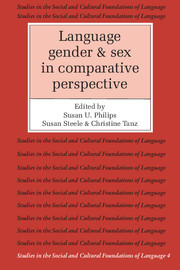Book contents
- Frontmatter
- Contents
- Acknowledgments
- List of contributors
- Introduction: The interaction of social and biological processes in women's and men's speech
- Part I Women's and men's speech in cross-cultural perspective
- Part II Gender differences in the language of children
- Introduction
- 6 Preschool boys' and girls' language use in pretend play
- 7 Sex differences in parent–child interaction
- 8 Children's arguing
- 9 Do different worlds mean different words?: an example from Papua New Guinea
- Part III Sex differences in language and the brain
- References
- Index
9 - Do different worlds mean different words?: an example from Papua New Guinea
Published online by Cambridge University Press: 05 June 2012
- Frontmatter
- Contents
- Acknowledgments
- List of contributors
- Introduction: The interaction of social and biological processes in women's and men's speech
- Part I Women's and men's speech in cross-cultural perspective
- Part II Gender differences in the language of children
- Introduction
- 6 Preschool boys' and girls' language use in pretend play
- 7 Sex differences in parent–child interaction
- 8 Children's arguing
- 9 Do different worlds mean different words?: an example from Papua New Guinea
- Part III Sex differences in language and the brain
- References
- Index
Summary
Many anthropologists working in Papua New Guinea have focused on the social relationships between the sexes (Brown and Buchbinder 1976; Langness 1967; Malinowski 1929; Mead 1935; Meggitt 1964; O'Brien and Tiffany 1984). For example, there have been extensive accounts of sexual antagonism and the separateness of men and women in a variety of social spheres in the Highlands. Indeed, the range of male–female relationships and ideologies found in Papua New Guinea has fascinated researchers for many years and has been the basis for developing theories in several different areas.
On the one hand, interest in male–female relations has been directed to issues of initiation, pollution, and self-concepts (see, for example, Faithorn 1975; Hays and Hays 1982; Herdt 1982; Poole 1981; Read 1954). Another direction has been away from the focus on individuals and toward seeing individuals as the vehicles for the creation and validation of social alliances. Out of this framework have come theories of social organization, marriage and exchange, and conception (e.g., Clay 1977; Glasse and Meggitt 1969; R. Kelly 1977; A. Strathern 1973; M. Strathern 1972; Wagner 1967; Weiner 1976). More recently, anthropologists have investigated the relationships among gender, nature, and culture in order to understand better the organization and ideology of social life (Gewertz 1983; Gillison 1980; Goodale 1980; Meigs 1976; A. Strathern 1979; M. Strathern 1980).
- Type
- Chapter
- Information
- Language, Gender, and Sex in Comparative Perspective , pp. 249 - 260Publisher: Cambridge University PressPrint publication year: 1987
- 19
- Cited by



